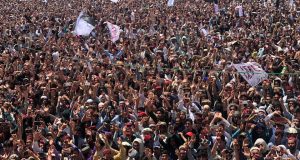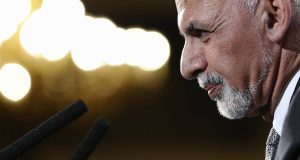Angry Pashtun tribesmen chanting anti-Taliban and freedom slogans torched the office of the Taliban in Pakistan’s northwestern province of Khyber Pakhtunkhwa, in response to the Jan. 3 police killing of Naqeebullah Mehsud, an inspiring Pashtun model, during a raid of what police said was a “terrorist hideout.” Mehsud’s death sparked a protest by young Pashtuns from throughout the Khyber Pakhtunkhwa province and tribal areas along the Durand Line, the border with Afghanistan, where, for decades, Pashtuns have suffered targeted killings by the Pakistani military and have protested against injustice and state-sponsored terrorism in their areas.
Now, protesters are asking for justice for Mehsud and demanding freedom for Khyber Pakhtunkhwa and the Federally Administered Tribal Areas (FATA).
Forcefully imposed by British India in 1893 over Afghan objections, the Durand Line and FATA area has turned into a hub of terrorism, insurgency and drug trafficking. People in the area proudly and publicly bear arms, sell smuggled goods and make weapons. For criminals, arms dealers, terrorist groups such as Al-Qaeda, Haqqani network and ISIS, the area has become somewhat of a safe haven. The semi-autonomous tribal region is a place where foreign jihadists, many of whom have been there for more than a decade, can take advantage of the lawlessness and benign support that Al-Qaeda and Taliban insurgents have received from Pakistan. Such activity in this location presents potentially dangerous consequences for U.S., NATO and Afghan troops in the region.
In this region, insurgents can retreat to tribal areas when U.S. and Afghan forces fight them, with the belief that neither U.S. nor Afghan forces will pursue them once they cross the boundary. Their Pakistani sympathizers will provide them with sanctuary and support. This trend has continued for 16 years but should be put to an end, because of the grave risk it poses to U.S. and Afghan forces.
Now is the time to change the status quo. This requires bold, confident decisions to address grievances of the people and redress mistakes of the past. In a May 2017 article published in The Pashtun Times, Ryszard Czarnecki, the former vice president of European Parliament, noted that “Pashtun-dominated tribal areas and portions of Pakistan that were forcefully taken away and merged into British India need to be restored to their earlier status as the sovereign territory of Afghanistan.” Indeed, it would be in the best interest of the United States, NATO and Afghanistan to redraw the Durand Line.
The Afghan government never has accepted the Durand Line as a true international border. The government and people of Afghanistan have consistently asked for the territory to be re-incorporated into Afghanistan. People who live along the Durand Line don’t consider it to be a border. They cross the border freely and, in many places, the line is unclear. Pashtun inhabitants along the line take pride in asserting their autonomy and proudly assert that their Pashtunwali traditions and tribal codes of conduct supersede the Pakistani laws and courts.
Redrawing the line, to merge FATA, Pakhtunkhwa and parts of Balochistan into Afghanistan could help to end the blood spilled in this region. This would eliminate the safe-haven status of the region for terrorists by bringing the lawless territory under the control of Afghanistan, where U.S. forces are operating. Eliminating the arbitrary, artificial border would be a great legacy for the United States and international community — winning over the hearts and minds of the region’s inhabitants by bringing together people who were forcefully divided more than a century ago.
In addition, redrawing the boundary would be a quick solution to reaching the collective objectives of the United States, NATO and Afghanistan. This would:
- Make it difficult for terrorists to use the area to plan and train for their operations, and will deny them a place to which they can escape the U.S., NATO or Afghan forces;
- Help in monitoring Al-Qaeda activities, since the terrorist group continues to seek opportunities to strike Western countries;
- Help to contain ISIS, whose members often hide in the mountains of the area;
- Help the United States with its stabilization efforts in Central and South Asia;
- Bolster the reputation of and regard for the United States, by promoting unity among people of the region.
Ultimately, bringing stability to this region, and getting rid of Pakistani-backed insurgency, could become a model of freedom. Redrawing the Durand Line and merging the territory into Afghanistan would give the country access to international waters, providing a win from a logistical and economic perspective for the United States, NATO and Afghanistan. This would pave the way for a direct connection between Central Asia and the Middle East. (First published in the HILL)
By Ahmad Shah Katawazai
The writer is an Afghan diplomat with the Ministry of Foreign Affairs and a national security expert. The views expressed are his own. Follow him on Twitter at @askatawazai.
 Pashtun Times Latest News
Pashtun Times Latest News




